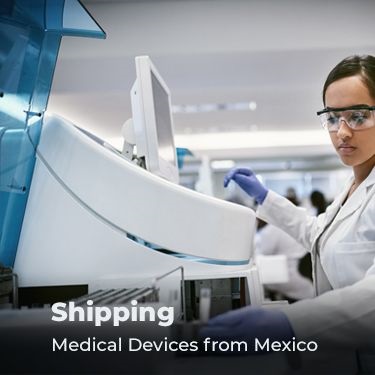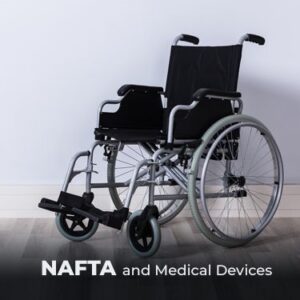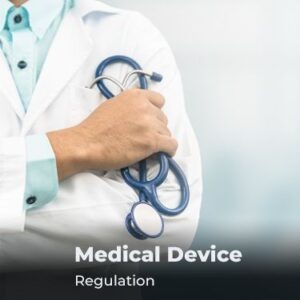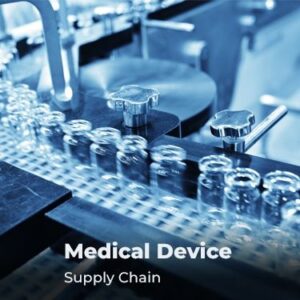
Por
 Copiar URL al Portapapeles
Copiar URL al Portapapeles
If you’re interested in shipping medical devices from Mexico, then you probably know that the process is highly regulated. However, you may not know that importers ship from Mexico into the U.S. all the time. In fact, a lot of the manufacturing companies in Mexico are actually American owned, so regular transport across the border is commonplace! The value of Mexico’s medical device exports totaled $11.6 billion USD in 2017, and trucks are constantly moving through the ports of entry, but that does not mean it will be easy.
Shipping medical devices from Mexico is a tense process. Devices must be appropriately classified, labeled, approved, monitored, and registered in order to gain clearance from the FDA. Additionally, importing from Mexico into the U.S. has other regulations, like a BOL, a customs bond, and a NAFTA certificate of origin.
Table of Contents
Factories in Mexico are now responsible for producing a huge variety of the medical devices in use in the U.S., and there are few limits on what they produce. The definition for medical devices in Mexico is wide-reaching and encompasses substances, electronics, instruments, software, and other equipment that is used in healthcare. This includes anything used to treat, diagnose, monitor, or prevent illnesses, as well as aesthetic and functional prosthetics used to correct disabilities or dysfunction. Anything involved in the alteration of anatomy and physiological processes, such as aesthetic implants, is also included in this definition.
Although that sounds confusing, it basically means that anything used for healthcare purposes in a medical facility falls under the definition of “medical device.” Even hospital gowns and tongue depressors are included in that definition!
Take a look at some of the medical devices commonly manufactured in Mexico:
COFEPRIS, the Federal Commission for Protection against Health Risks, is part of the Mexican Ministry of Health, and it is the division responsible for overseeing medical devices and In Vitro Diagnostics (IVD). It is the regulatory division for protecting people from devices that could be manufactured poorly, not sterile, poorly designed, or otherwise harmful to patients.
Think of this division as the Mexican equivalent of the Food and Drug Administration’s (FDA) Center for Devices and Radiological Health (CDRH). That’s a bit of a mouthful, but the activities that COFEPRIS is engaged in are fairly simple.
COFEPRIS duties include:
 NAFTA and Medical Devices
NAFTA and Medical DevicesThe North American Free Trade Agreement (NAFTA), now replaced with the United States-Mexico-Canada Agreement (USMCA), is a trade agreement between those three countries to remove tariffs and other foreign trade barriers on certain commodities. Although the terms that were renegotiated in 2017 negatively impacted many industries, the medical device industry faced a few potentially beneficial changes—for consumers and manufacturers!
Some of these changes are:
Those are only a few of the ways that the trade agreement benefits the medical device industry, to cut down on border crossing times. These policies also reduce the final costs and improve the quality for the final consumer.
 Medical Device Regulation
Medical Device RegulationThanks to the USMCA harmonization of medical device regulation, you should not need to worry about redundancies in the process of getting your shipment across the border. However, that does not mean that it will be easy. The process for regulating medical devices is a complicated one, and there are many things you need to know to ensure regulatory compliance.
Before being exported from Mexico, medical devices must be classified into different categories based on their potential risk. There are three different classes that medical devices can fall into:
Medical device labeling is an important part of preparing for import into the U.S. In order to be compliant, all devices must meet a set of minimum requirements. Depending on the device, its Class, and where it will be used, there may be more specific requirements to follow as well.
At the very least, all medical devices must have:
Failing to follow these labeling requirements could result in serious delays, but it is unlikely that your devices would be turned away just because of mislabeling, as long as the mistakes were not deliberate. Chances are, the faulty labels could be fixed at the port, and then brought over the border.
The regulatory approval process for Class III medical devices is extremely stringent. In order to market a potentially life-saving or risky device, you would need to file a Class III 510(k) with the FDA. The FDA will then investigate the device to ensure that it is effective for its intended use or uses, without causing an unreasonable amount of harm to the user or patient.
If the FDA determines that the device is allowed to enter the U.S. market, then the device is granted Premarket Approval (PMA), and you can move on to the next step.
Class I and II devices do not need to file for PMA, but shippers do need to file Premarket Notification (PMN). This is another 510(k) document, but it does not entail as close of an inspection as those for Class III devices. PMN should be filed at least 90 days before the date of their intended introduction to market, since you will not be able to market your medical device until after this PMN has been acknowledged by the FDA.
Postmarket surveillance is when a device that has been released to the public for the first time is monitored and tested, to ensure that it effectively does what it claims, and does not cause undue harm. Usually, this requires keeping up with the users of the device, and making note of everything. Any complications regarding the device is investigated, to see if it trends as being more harmful than helpful.
Postmarket surveillance is helpful for determining how the device works on large, diverse groups of people, while continuing to ensure safety and quality. If a large percentage of people experience the same concerning complications as a result of the device, it may be determined to be harmful on that statistical basis.
If a device is found to cause unreasonable harm, is unpredictable, unreliable, or otherwise concerning, the FDA maintains the right to pull the device from the market to protect the general population. Fortunately, if your device is pulled from the market, you could still try to fix the problems with it and re-register with the FDA to get back onto the market.
This postmarket surveillance is required for Class III devices, and sometimes Class II devices, but Class I devices are usually exempt.
The registration process for medical devices is a fairly simple one, but you should still make sure you read through all the instructions carefully. In order to register a device in Mexico for export, you must submit specific documentation to the FDA, including:
For the most part, Class I devices do not need to follow this procedure, as they are easily self-registered.
 Packing and Shipping Medical Devices
Packing and Shipping Medical DevicesThe best practices for packing and shipping medical devices really depends on the type of medical device you’re shipping. As demonstrated earlier, the medical device industry is huge, and encompasses many different types of products. Additionally, you’re going to need to know the specific processes for clearing customs for Mexico cross-border shipping.
Shipping something like boxes of latex gloves would be ideal, since they would be easy to palletize and they do not require any special treatment to ensure they stay intact during shipping. Other items have special requirements, however. Electronics like pacemakers and hearing aids, for example, cannot be allowed to get wet. Likewise, some items may require specific temperatures to be maintained during transit, like disinfectants and burn treatments.
Failure to store your medical device correctly will most likely result in your product becoming unusable. The FDA does not want to take chances with people’s health, so even if it doesn’t seem like there is anything wrong with your product after storing it improperly, it likely won’t be accepted anyway.
It is important to communicate the specific instructions for storing your product to your carrier, to ensure that no mistakes are made. However, mistakes can be made anyway, and they can be difficult to catch before it’s too late. But there is a solution!
If you work with a third-party logistics company, you could ensure that your carrier is trustworthy, and even set up special tracking modules to monitor the speed, temperature, and location of your shipment. You could notice if the temperature isn’t correct before your shipment gets damaged.
As with any import, importing medical devices from Mexico to the U.S. is going to require some specific documents to clear customs. In order to be allowed through customs, the shipment will need to be accompanied by:
A licensed customs broker can assist you with getting all the documents for your shipment in order. It is a complicated process, and it can be a lot to manage if you’re trying to do it all without any help. A customs broker can also assist with keeping you up to date on changing regulations, and can handle all the paperwork on your behalf.
 Medical Device Supply Chain
Medical Device Supply ChainMedical devices manufactured in Mexico start in special assembly plants known as maquiladoras, which are typically American owned operations, commonly located in border towns in Mexico. These plants usually ship in raw materials, either from other places in Mexico or the U.S., assemble the parts into finished products, and then export them into the U.S.
Once a product is finished, it goes to a warehouse to be stored until it can be shipped out in a freight truck. These warehouses may require additional features to ensure the highest quality and safety for the products, like extra guards or refrigeration. When it is time to move the products, they are loaded onto freight trucks and taken to a Port of Entry to cross the border. These ports can be found in places like Laredo, El Paso, and San Ysidro.
Once in the U.S., the products are then moved into another warehouse, where they will be kept until they are ordered by a hospital, drugstore, or other customers. When an order is received, the items are packed onto another truck to be delivered.
The Federal Motor Carrier Safety Administration (FMCSA) dictates that all carriers moving over the border must be appropriately licensed and certified to operate in both the U.S. and Mexico. Otherwise, you would need a Mexican-domiciled carrier to take your cargo to the port, then load it onto a U.S. carrier to finish the trip, which can cost you time and potentially damage your shipment.
When selecting a freight service for shipping medical devices from Mexico, it is important to find a carrier that is trusted and well respected, with a reputation for successful deliveries. When dealing with Mexico cross-border shipments, it can be difficult to monitor your freight, so you should try to find a carrier that will be open and willing to communicate with you transparently.
Alternatively, you could utilize a global third-party logistics company (3PL) to handle the hard work for you. They could find you a trusted carrier to move your freight, and can be a point of contact between you and the carrier so you can always know what’s going on with your shipment. Working with a 3PL can give you the greatest chance of success, and seriously reduce the chances of something going wrong with your shipment.
Shipping medical devices from Mexico doesn’t have to be a difficult task. With R+L Global Logistics, you don’t have to stress about dealing with carriers. Our multi-lingual staff has over 30 years of cross-border experience, so you can rest easy knowing that your shipment is in good hands! We offer expedited shipping, warehousing solutions, refrigerated trucking, freight visibility, and much more! No matter whether you're seeking Otay Mesa cross bording shipping or you plan to cross the border at another port, R+L Global Logistics is prepared to be your strategic partner.
If you’re ready to ship medical devices from Mexico, contact us today for a quote!
 Copiar URL en el Portapapeles
Copiar URL en el Portapapeles
